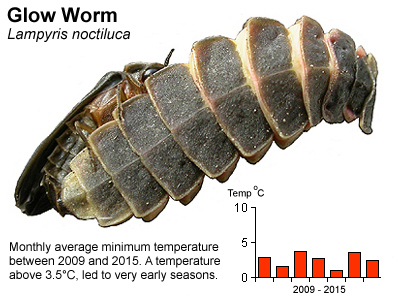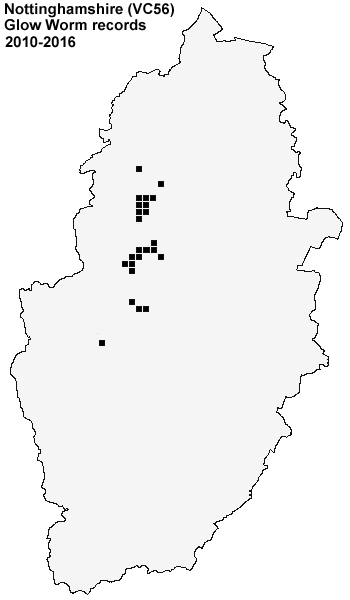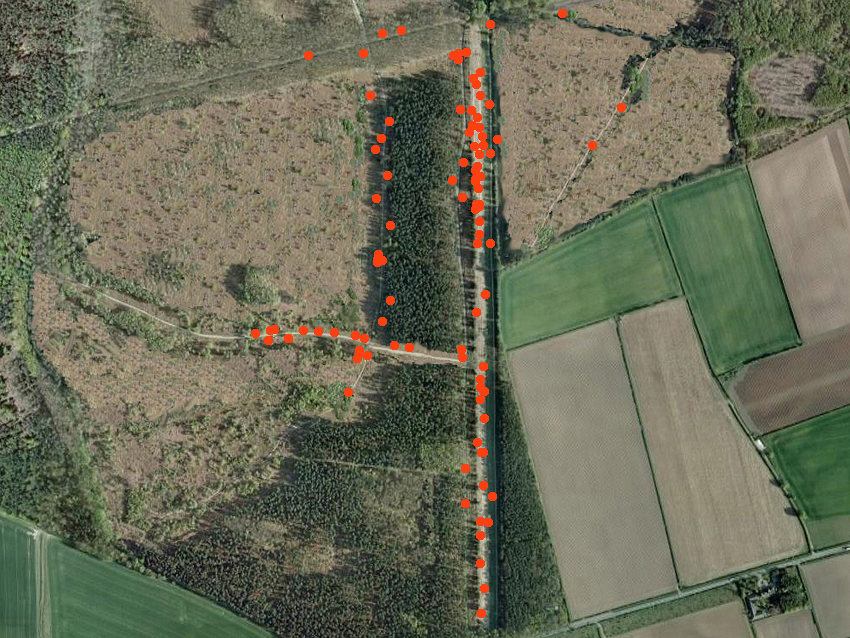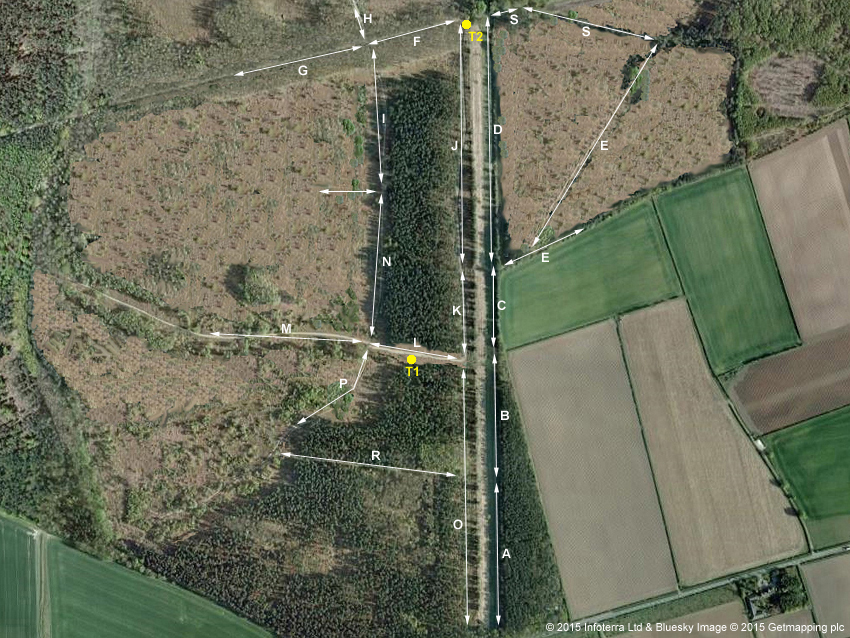

| Glow Worms at Sherwood Forest 2015 |
| Latest
update - July 19th 2015 There was no continuous coverage this year and we restricted our site visits to less than one per week, only counting the Glow Worms present on each visit and not marking them as we have in previous years. The first female appeared earlier than expected on May 23rd and just four females had emerged by June 6th. In other words, this has been a late season and with a very slow build up in numbers. A count of 41 females was recorded on June 22nd, but we may have missed a higher count on the nights preceding, or after this date. A recent visit on July 19th, produced just one female. |
||
| Predicting the
first Glow Worm of the year A week or so ago, we were predcting that the first female Glow Worm would appear at the end of the month and that the 2015 season would be quite a late one. More on the method of prediction we used follows and it turns out that we were wrong by about a week. The first female of 2015 appeared on May 23rd, in Section J of the survey area. This is the third earliest date we have recorded. Based on the lack of reports so far, this is probably the first Glow Worm to appear anywhere in the UK this year. Predicting the date of when the first female Glow Worm will appear in 2015, is something we have been asked by a number of people during April and early May. Its something we have actually tried to do at the start of each glowing season for the last few years, so we have recently spent a great deal of time trying to find a reliable method of prediction. We looked at the data for a number of potential factors (all of which were climatic) but which might provide a link to the appearance of the first female Glow Worms. Despite our efforts, the science of predicting an accurate date still seems down to guesswork, albeit based on a fair degree of knowledge and experience. |
 |
|
| ..... | ||
|
The resulting data from our recording of Glow Worms at Clipstone Old Quarter goes back to 2009, but we used certain climate data from the latter part of 2008, in order to try and find any possible correlation. The average minimum and maximum temperature between the months of January and April, produced what seemed to be a promising link between average minimum/maximum temperature and female first date. | ||||||||||||||||||||||||||||||||||||||||||||||||||||||||||||||||
| ..... | |||||||||||||||||||||||||||||||||||||||||||||||||||||||||||||||||
|
In 2011 and 2014, female Glow Worms at Clipstone Old Quarter appeared unusually early - on May 13th and May 18th respectively. Both dates came as a direct result of two very mild, late Winter periods when the average minimum January to April temperature was above 3.5°C. The average minimum temperature difference between the two years was as little as 0.05°C. | ||||||||||||||||||||||||||||||||||||||||||||||||||||||||||||||||
| ..... | |||||||||||||||||||||||||||||||||||||||||||||||||||||||||||||||||
| In contrast,
June 8th 2013 was easily the latest start to a season we
recorded and was attributable to a much lower average
minimum January to April temperature of just 1.05°C.
With average minimum temperatures above 3.5°C from
January to April, the first female will certainly be
early. Temperatures below an estimated 2.25°C should
mean a much later season, but May 24th 2010 opens this up
for some debate as despite an average minimum temperature
of just 1.62°C, the first female appeared more or less
on time. There could be other (more subtle) influencing
factors that a more in depth study might reveal. Average
minimum temperatures between 2.25°C and 3°C are likely
to produce first dates between May 24th and May 31st. Even when we incorporated the average minimum temperature data for November and December, no difference was made to the results and it now seems clear to us that the emergence date of the first female Glow Worm, is more reliant on the average temperature during January to April than November to April. |
|||||||||||||||||||||||||||||||||||||||||||||||||||||||||||||||||
| ..... |
 |
| ..... |
| The average maximum
temperature data, showed that a temperature over
10.50°C, led to the early first dates of May 13th and
May 18th, while an average temperature of just under 7°C
resulted in a late season (June 8th 2013). Once again,
2010 spoiled the theory to a degree, but the basic
pattern of average maximum temperature and female first
date, worked out the same as it did when using the
average minimum temperature data. Based on the data we
have, we believe that an average (normal?) date for the
first female Glow Worm at Clipstone Old Quarter would be
May 27th (+/- 2days). So, following a cool late Winter and early Spring, we're predicting that the first female Glow Worm of 2015 will appear on May 31st (+/- 2days). |
| ..... |
| A
short summary of larval size data between Spring 2009 and
2015 Part of our study since 2009, has been the counting and measuring the length of Glow Worm larvae found in four survey sections during the Spring. These surveys took place while still light, during the late afternoon and early evening periods. The gathering of larval size data had to come to an end in the middle of April 2015, but we believe that we had more than enough data, to suggest that the average larval size between March and May of each year, ultimately had no bearing on the emergence date of female Glow Worms a few weeks later. |
||||||||||||||||||||||||||||||||||||||||||||||||||||||||||||||||||||||||||||||||||||||||||||||||||||||||||||||||||||||||||||||||||||||||||||||||||||||||||||
| ..... | ||||||||||||||||||||||||||||||||||||||||||||||||||||||||||||||||||||||||||||||||||||||||||||||||||||||||||||||||||||||||||||||||||||||||||||||||||||||||||||
|
||||||||||||||||||||||||||||||||||||||||||||||||||||||||||||||||||||||||||||||||||||||||||||||||||||||||||||||||||||||||||||||||||||||||||||||||||||||||||||
| ..... | ||||||||||||||||||||||||||||||||||||||||||||||||||||||||||||||||||||||||||||||||||||||||||||||||||||||||||||||||||||||||||||||||||||||||||||||||||||||||||||
| The larval
size data has produced some interesting results. We found
that the average larval size taken over the six Spring
periods was 20.32mm, based on data gathered from a total
of 771 larvae. It also showed that larvae were
considerably larger on average in 2009 (22.21mm) than in
any of the following years, equating to 1.89mm larger
than the average produced between 2010 and 2015. The size data produced since 2010 has been remarkably consistant, showing a variation of just 1.40mm. Breaking the data down further, the average size variation in three of the years since (2011, 2013 and 2014) showed variation as little as 0.06mm. If we exclude the 2009 size data on the basis of being unusually large, then an average larval size at this site would be approximately 20.00mm. The relative consistant larval sizes suggests to us that variations in rainfall and temperature between November and March in any year, actually had no influence on larval size. |
||||||||||||||||||||||||||||||||||||||||||||||||||||||||||||||||||||||||||||||||||||||||||||||||||||||||||||||||||||||||||||||||||||||||||||||||||||||||||||
| ..... | ||||||||||||||||||||||||||||||||||||||||||||||||||||||||||||||||||||||||||||||||||||||||||||||||||||||||||||||||||||||||||||||||||||||||||||||||||||||||||||
| The Glow Worm in
Nottinghamshire - an overview Despite still being described by some authorities as common, evidence we have gathered through our own surveying and monitoring of Nottinghamshire's Glow Worm colonies since 2008, shows that the Glow Worm is clearly in a serious decline. However, the decline is still denied by many and having no conservation status doesn't help matters, effectively meaning that site managers, owners and conservation organisations do not have to take any measures to protect Glow Worms on their sites. Yet many do, realising that the Glow Worm presents them with a great public relation, or engagement opportunity. The total number of sites in Nottinghamshire where the Glow Worm survives, is currently down to just 19, effectively disappearing from most of its 49 known Nottinghamshire sites. Clumber Park, Sherwood Forest and Sherwood Pines, are now the best areas in the county to see Glow Worms, but they are decreasing at an alarming rate, even at particular sites within these strongholds. Glow Worms in 2014 All in all, 2014 proved to be a good year in terms of Glow Worm numbers at Clipstone Old Quarter, but there continue to be worrying trends and prospects for Glow Worm populations in some of the more isolated sections of the study area. We were able to show how damaging to small invertebrate populations, commercial forestry can be and will continue to be in 2015. The (hopefully) final phase of Pine removal was to take place this last Winter, but it seems will not be going ahead before the onset of this years glowing season. It is the timber extraction process which has proved to be most destructive in previous years and some of the better Glow Worm areas at Clipstone Old Quarter will be affected by both this and track maintainance. Of course, we will monitor and report on this later this year. |
 |
|
| 2015
Glow Worm sightings (Clipstone Old Quarter) |
|||||||||
| Our normal continuous coverage is unlikely this year, but we hope to be able to provide regular updates during 2015. | |||||||||
| Glow Worms (both adults and larvae) are recorded as follows.....L = larva ..... M = male .....F = female | |||||||||
| ........................ | ||||||
| Date | Stage | Additional notes | ||||
| ................ | .L. | M. | .F. | llowing a pleasant sunny day. Temperature.......................... dropped quickly to 6°C at T2 at 17:30h. Site visited from | ||
| March 7th | 1 | 0 | 0 | A single 15mm larvae recorded from section D this evening, was the first of 2015. A temperature of 12°C recorded at T2. Site visited from 17:45h-18:45h. | ||
| ................. | ||||||
| March 17th | 0 | 0 | 0 | No larvae recorded this evening. Temperature 6°C at T2. Site visited from 17:30h-18:30h. | ||
| ................. | ||||||
| April 2nd | 2 | 0 | 0 | Two larvae recorded from section D this evening, measuring 17mm and 24mm. A temperature of 12°C recorded at T2. Site visited from 17:05h-18:05h. | ||
| ................. | ||||||
| April 5th | 2 | 0 | 0 | Two larvae recorded from section D this evening, both measuring 17mm. A temperature of 14°C recorded at T2. Site visited from 17:30h-18:40h. | ||
| ................. | ||||||
| April 6th | 2 | 0 | 0 | Two larvae (19mm and 15mm) recorded from sections D and A this evening. A temperature of 13°C recorded at T2. Site visited from 18:35h-19:45h. | ||
| ................. | ||||||
| April 7th | 0 | 0 | 0 | No larvae recorded this evening. A temperature of 14°C recorded at T2. Site visited from 18:35h-19:40h. | ||
| ................. | ||||||
| April 8th | 2 | 0 | 0 | Two larvae (15mm and 23mm) recorded from sections D and B this evening. A temperature of 13°C recorded at T2. Site visited from 18:30h-19:30h. | ||
| ................. | ||||||
| April 10th | 3 | 0 | 0 | Three larvae recorded this evening and two larvae found dead in sections B and C. A temperature of 19°C recorded at T2. Site visited from 18:35h-19:45h. | ||
| ................. | ||||||
| April 11th | 0 | 0 | 0 | No larvae recorded this evening. A temperature of 11°C recorded at T2. Site visited from 18:40h-19:40h. | ||
| ................. | ||||||
| April 13th | 11 | 0 | 0 | 11 larvae recorded this evening. A temperature of 14°C recorded at T2. Site visited from 18:40h-19:55h. | ||
| ................. | ||||||
| April 15th | 3 | 0 | 0 | Three larvae recorded this evening, all in section D. One of the larvae was found to be missing it's last three segments (having only nine) but was behaving quite naturally. Closer inspection revealed that the wound was well healed and dry, with no loss of bodily fluid. The larva's size and healthy appearance, also indicated that normal feeding must have occurred and over-wintering had been successful. A temperature of 12°C was recorded at T2. Site visited from 18:45h-19:50h. | ||
| ................. | ||||||
| April 16th | 4 | 0 | 0 | Four larvae recorded from the regular survey sections of A, B, C and D this evening, with a dead larva also found. A feeding larva was found underneath a log, in the grass strip and is not included in the total given. A temperature of 13°C was recorded at T2. Site visited from 18:40h-19:40h. | ||
| ................. | ||||||
| May 10th | 0 | 0 | 0 | The first survey for early adults this evening, produced no females. All areas were surveyed, with temperature of 11°C at T1 and 13°C at T2. Site visited from 21:30h-22:40h. | ||
| ................. | ||||||
| May 13th | 0 | 0 | 0 | No females recorded this evening. Cooler with site temperatures of 8°C at T1 and 9°C at T2. Site visited from 21:50h-22:45h. | ||
| ................. | ||||||
| May 18th | 0 | 0 | 0 | No females this evening. Low site temperatures of 7°C at both T1 and T2. Site visited from 21:45h-22:35h. | ||
| ................. | ||||||
| May 19th | 0 | 0 | 0 | No females found again this evening. Recorded site temperatures of 8°C at T1 and 9°C at T2. The site was visited from 21:45h-22:40h. | ||
| ................. | ||||||
| May 20th | 0 | 0 | 0 | No females recorded again this evening. Site visited from 21:50h-22:45h, with temperatures of 8°C at T1 and 9°C at T2. | ||
| ................. | ||||||
| May 21st | 0 | 0 | 0 | No females found this evening, with recorded temperatures of 13°C at T1 and 14°C at T2. Site visited from 21:50h-22:45h. | ||
| ................. | ||||||
| May 22nd | 0 | 0 | 0 | No females found, despite a thorough search of all sections and site temperatures of 12°C at T1 and 13°C at T2. Site visited from 21:55h-23:00h. | ||
| ................. | ||||||
| May 23rd | 0 | 0 | 1 | The first female Glow Worm of 2015 (including the whole of the UK) was found in the upper part of Section J this evening. Site temperatures of 9°C at T1 and 10°C at T2. Site visited from 21:45h-23:20h. | ||
| ................. | ||||||
| May 24th | 0 | 0 | 1 | Still the one female present this evening in Section J. Site temperatures of 8°C at T1 and 9°C at T2. Site visited from 21:45h-23:15h. | ||
| ................. | ||||||
| May 27th | 0 | 0 | 3 | Three females present this evening, with a second female within two metres of this year's first in Section J and a third found in Section E. A site temperature of 10°C was recorded from both T1 and T2. Site visited from 21:55h-23:10h. | ||
| ................. | ||||||
| May 29th | 0 | 0 | 1 | Just one female found glowing this evening, on what was a very cool visit. A site temperature of 7°C was recorded at T1 and only 8°C at T2. Site visited from 22:15h-23:10h. | ||
| ................. | ||||||
| June 3rd | 0 | 0 | 3 | The three same females present on May 27th remain and with no new females appearing. A site temperature of 9°C was recorded at T1 and 10°C at T2. Site visited from 22:15h-23:30h. | ||
| ................. | ||||||
| June 6th | 0 | 0 | 4 | Four females found ths evening, with two new females in Section M and one in Section J. The first female of 2015 remains in Section J. A site temperature of 11°C was recorded at T1 and 12°C at T2. Site visited from 22:15h-23:45h. | ||
| ................. | ||||||
| June 11th | 0 | 0 | 18 | 18 females found ths evening. The first female of 2015 remains in Section J and is now at least 20 days old. A site temperature of 13°C was recorded at T1 and 14°C at T2. Site visited from 22:30h-23:45h. | ||
| ................. | ||||||
| June 17th | 0 | 0 | 13 | 13 females found ths evening. A site temperature of 12°C was recorded at T1 and 14°C at T2. Site visited from 22:30h-23:45h. | ||
| ................. | ||||||
| June 22nd | 1 | 0 | 41 | A total of 41 females found ths evening, most of which came from the grass sections of A, B, C and D. A site temperature of 10°C was recorded at T1 and 11°C at T2. Site visited from 22:20h-00:00h. | ||
| ................. | ||||||
| July 7th | 0 | 1 | 32 | A total of 32 females found ths evening, and one male. A site temperature of 13°C was recorded at T1 and 14°C at T2. Site visited from 22:15h-00:40h. | ||
| ................. | ||||||
| July 19th | 2 | 0 | 1 | Just one female present in Section J and single larvae recorded in Sections E and O this evening. Site temperatures of 9°C at T1 and 11°C at T2, with the site visited from 22:15h-23:50h. | ||
| Below:- Arial map showing the positions of the first three female Glow Worms at Clipstone Old Quarter during 2015. |
| ................. |
 |
| ................. |
| Below:- Arial map showing the survey route we take each night, when surveying for female Glow Worms. Sections A, B, C and D are the only areas where larval counts are made. The two yellow dots show the two locations (highest and lowest points on site) where the temperature is taken during the season. |
| ................. |
 |